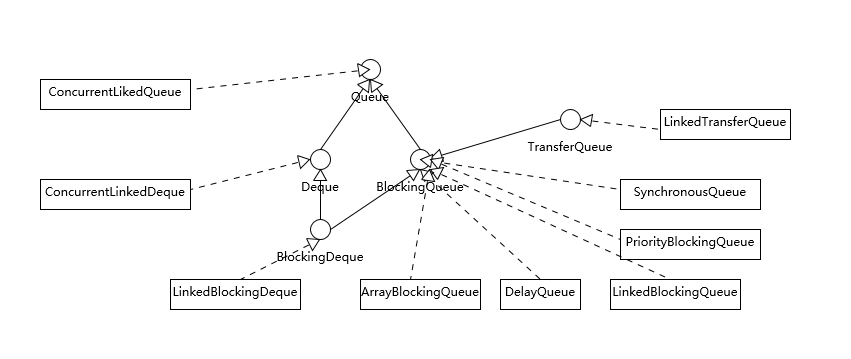Java Blocking Queue
ConcurrentLinkedQueue 和 LinkedBlockingQueue 有什么区别
- Concurrent 类型基于 lock-free,在常见的多线程访问场景,一般可以提供较高吞吐量。
- LinkedBlockingQueue 内部则是基于锁,并提供了 BlockingQueue 的等待性方法。
线程安全队列一览
常见的集合中 LinkedList 是个 Deque,只不过不是线程安全的。
下图展示了 Java 并发类库提供的各种线程安全队列实现:

Deque
Deque 侧重点是支持队列头尾都进行插入和删除,所以提供了特定的方法,如:
- 尾部插入时需要的 addLast(e)、offerLast(e).
- 尾部删除所需要的 removeLast()、pollLast().
JUC 包中绝大部分 Queue 都实现了 BlockingQueue 接口。在常规队列操作基础上,Blocking 意味着其提供了特定的等待性操作,获取时(take)等待元素进队,或者插入时(put)等待队列出现空位。
/**
* 获取并移除队列头结点
*/
E take() throws InterruptedException;
/**
* 插入元素,如果队列已满,则等待直到队列出现空闲空间
*/
void put(E e) throws InterruptedException;
另一个 BlockingQueue 经常被考察的点,就是是否有界(Bounded、Unbounded),这一点也往往会影响我们在应用开发中的选择。
- ArrayBlockingQueue 是最典型的有界队列,其内部以 final 的数组保存数据,数组的大小就决定了队列的边界,所以我们在创建 ArrayBlockingQueue 时,都要指定容量,如:
public ArrayBlockingQueue(int capacity, boolean fair)
- LinkedBlockingQueue 基于有界的逻辑实现,不过其默认初始容量为
Integer.MAX_VALUE,成为无界队列。 - SynchronousQueue 每个删除操作都要等待插入操作,反之每个插入操作也都要等待删除操纵。那么这个队列的容量时多少呢?0.
- PriorityBlockingQueue 是无边界的优先队列,其大小受系统资源影响。
- DelayedQueue 和 LinkedTransferQueue 同样是无边界队列。对于无边界的队列,有一个自然的结果,就是 put 操作永远也不会发生其他 BlockingQueue 的那种等待情况。
我们看下 LinkedBlockingQueue 的实现:
/** Lock held by take, poll, etc */
private final ReentrantLock takeLock = new ReentrantLock();
/** Wait queue for waiting takes */
private final Condition notEmpty = takeLock.newCondition();
/** Lock held by put, offer, etc */
private final ReentrantLock putLock = new ReentrantLock();
/** Wait queue for waiting puts */
private final Condition notFull = putLock.newCondition();
我们之前提到过 ArrayBlockingQueue 中的 notEmpty、notFull 都是同一个再入锁的条件变量,而 LinkedBlockingQueue 则改进了锁操作的粒度,头、尾操作使用不同的锁,所以在通用场景下,它的吞吐量相对要更好一些。
下面 take 方法与 ArrayBlockingQueue 中的实现,也是有不同的,由于其内部结构是链表,需要自己维护元素的数量值:
public E take() throws InterruptedException {
final E x;
final int c;
final AtomicInteger count = this.count;
final ReentrantLock takeLock = this.takeLock;
takeLock.lockInterruptibly();
try {
while (count.get() == 0) {
notEmpty.await();
}
x = dequeue();
c = count.getAndDecrement();
if (c > 1) {
notEmpty.signal();
}
} finally {
takeLock.unlock();
}
if (c == capacity) {
signalNotFull();
}
return x;
}
类似 ConcurrentLinkedQueue 等,则是基于 CAS 的无锁技术,不需要在每个操作时使用锁,所以扩展性变现要更加优异。
相对比较另类的 SynchronousQueue,Java6 中,其实现发生了非常大的变化,利用 CAS 替换掉了原本基于锁的逻辑,同步开销比较小。它是 Executors.newCachedThreadPool() 的默认队列。
队列使用场景与典型用例
在实际开发中,Queue 被广泛用于生产者-消费者场景,比如利用 BlockingQueue 来实现,由于其提供的等待机制,我们可以少做很多协调性的工作,可以参考如下示例:
import java.util.concurrent.ArrayBlockingQueue;
import java.util.concurrent.BlockingQueue;
public class ConsumerProducer {
private static final String EXIT = "Good bye!";
public static void main(String[] args) {
BlockingQueue<String> queue = new ArrayBlockingQueue<>(3);
Producer producer = new Producer(queue);
Consumer consumer = new Consumer(queue);
new Thread(producer).start();
new Thread(consumer).start();
}
static class Producer implements Runnable {
private BlockingQueue<String> queue;
public Producer(BlockingQueue<String> q) {
this.queue = q;
}
@Override
public void run() {
for (int i = 0; i < 20; i++) {
try {
Thread.sleep(5L);
String msg = "Message" + i;
System.out.println("Produced new item: " + msg);
queue.put(msg);
} catch (Exception e) {
e.printStackTrace();
}
}
try {
System.out.println("OK funs over!");
queue.put(EXIT);
} catch (Exception e) {
e.printStackTrace();
}
}
}
static class Consumer implements Runnable {
private BlockingQueue<String> queue;
public Consumer(BlockingQueue<String> q) {
this.queue = q;
}
@Override
public void run() {
try {
String msg;
while (!EXIT.equalsIgnoreCase((msg = queue.take()))) {
System.out.println("Consumed item: " + msg);
Thread.sleep(10L);
}
System.out.println("OK got exit msg!");
} catch (Exception e) {
e.printStackTrace();
}
}
}
}
上面是一个典型的生产者-消费者模型,如果使用非 Blocking 的队列,那么我们就要自己去实现轮询、条件判断(如检查 poll 返回值是否 null)等逻辑,如果没有特别的场景要求,Blocking 实现起来代码更加简单、直观。
各种 Blocking 的使用场景
以 LinkedBlockingQueue、ArrayBlockingQueue 和 SynchronousQueue 为例,我们根据需求可以从多方考量:
- 从队列边界要求看,ArrayBlockingQueue 有明确的容量限制,而 LinkedBlockingQueue 则取决于我们是否在创建时指定,SynchronousQueue 则不能缓存任何元素。
- 从空间利用效率看,数据结构的 ArrayBlockingQueue 要比 LinkedBlockingQueue 紧凑,因为不需要创建节点,但是其初始分配阶段就需要一段连续的空间,所以初始内存需求更大。
- 通用场景中,LinkedBlockingQueue 的吞吐量一般优于 ArrayBlockingQueue,因为它实现了更加细粒度的锁操作。
- ArrayBlockingQueue 实现比较简单,性能更好预测,属于表现稳定的结构。
- 如果我们需要实现两个线程之间接力性(handoff)的场景,除了 CountDownLatch,SynchronousQueue 也是完美符合这种场景的,而且线程间协调和数据传输统一起来,代码更加规范。
- 很多时候 SynchronousQueue 的性能表现,往往大大超过其他实现,尤其是在队列元素较小的场景。
Synchronous Handoffs Implementation
import java.util.concurrent.ExecutorService;
import java.util.concurrent.Executors;
import java.util.concurrent.SynchronousQueue;
import java.util.concurrent.ThreadLocalRandom;
import java.util.concurrent.TimeUnit;
public class HandoffSample {
private static ExecutorService executor = Executors.newFixedThreadPool(2);
private static SynchronousQueue<Integer> queue = new SynchronousQueue<>();
private static Runnable producer = () -> {
Integer producedElement = ThreadLocalRandom.current().nextInt();
try {
System.out.println("Saving an element: "+ producedElement +" to the exchange point");
queue.put(producedElement);
} catch (InterruptedException e) {
e.printStackTrace();
}
};
private static Runnable consumer = () -> {
try {
Integer consumedElement = queue.take();
System.out.println("Consumed an element: "+ consumedElement +" from the exchange point");
} catch (InterruptedException e) {
e.printStackTrace();
}
};
public static void main(String[] args) throws InterruptedException {
executor.execute(producer);
executor.execute(consumer);
executor.awaitTermination(500L, TimeUnit.MILLISECONDS);
executor.shutdown();
assert(queue.size() == 0);
}
}
打印出的 log:
Saving an element: 466241464 to the exchange point
Consumed an element: 466241464 from the exchange point